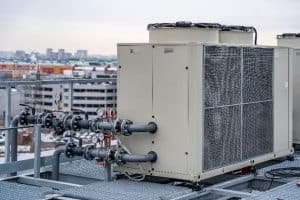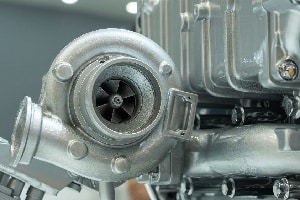Category: Press Release
PRESS RELEASE: How to Make Concrete Structures More Sustainable with MCI®-2005
PRESS RELEASE: Back to the Basics of Rust Removal for Easy Asset Restoration!
PRESS RELEASE: Don’t Sweat It This Summer: How to Avoid Corrosion in Backup Chiller Pumps
 Summer is coming to the Northern Hemisphere, which means hospitals and universities will soon be gearing up their comfort cooling systems for use. While it is standard for these institutions to have backup pumps for chillers and closed loop systems, it is also common for these pumps to develop corrosion problems during the offline phase. Cortec® offers relief from these corrosion complications with two water treatments that contain Vapor phase Corrosion Inhibitors.
Summer is coming to the Northern Hemisphere, which means hospitals and universities will soon be gearing up their comfort cooling systems for use. While it is standard for these institutions to have backup pumps for chillers and closed loop systems, it is also common for these pumps to develop corrosion problems during the offline phase. Cortec® offers relief from these corrosion complications with two water treatments that contain Vapor phase Corrosion Inhibitors.
Pros and Cons of Pump Redundancy
Hospitals especially—but also universities—need to have redundant systems to make sure operations continue in the case of emergency. If one pump fails, a backup pump will ensure the chiller or closed loop keeps operating with little to no change noticed by the people inside the facility. Unfortunately, the offline period is an extremely vulnerable time for pumps because they are not exposed to their normal corrosion inhibiting water treatment when no water is flowing through. To counter potential surprises and make sure the backup pumps stay in good condition, facilities often alternate between pumps every week or two. However, corrosion can still happen in this short layup period, introducing a slug of corrosion products into the piping when the pump is turned on. This can cause clogging and other complications for a less than smooth startup.
The Cortec® Corrosion Inhibitor Advantage
One advantage of Cortec® closed loop water treatments is that they protect in multiple phases. Not only do they dissolve in water to fight corrosion on surfaces in direct contact with the circulating stream, but they also work in the vapor-phase, protecting metal surfaces above the water level. This vaporphase action is exactly what is needed for pumps and piping that are periodically emptied but may contain residual water. Even if the system is complex or empty, Vapor phase Corrosion Inhibitors are able to protect in areas that contact-only corrosion inhibitors cannot reach.
Layup of Chiller Pumps on Standby
VpCI®-649 is a Cortec® water treatment recommended for protection of chiller pumps. It should be added to the closed loop / chiller water and circulated through the system before the pumps are shut down, leaving behind a corrosion inhibiting film that protects multi-metals above and below the waterline. Dosage is dependent on the length of protection needed—a smaller dose during operation and an incrementally larger dose for longer periods of layup (up to two years). There is typically no need to flush the inhibitor out before bringing the pump back online, making the transition even more seamless than simply having a lower chance of corrosion complications. VpCI®-649 comes with a molybdate tracer for easy detection but is also available with a PTSA tracer for those with molybdate restrictions.
For pumps used with HVAC closed loops that reach temperatures of up to 302 °F (150 °C), Cortec® recommends using M-640 L, which also contains contact and Vapor phase Corrosion Inhibitors. It is an excellent replacement for silicates and phosphate/nitrite-based compounds and protects yellow and ferrous metals. It can be used in closed loops during operation or layup, allowing great flexibility for maintenance personnel or water treatment service providers.
Don’t Sweat It This Summer
Summer is hot, which is why hospitals and universities use comfort cooling systems in the first place. But there is no need to increase the extra heat and sweat of stress from trying to undo a corrosion problem on chiller pumps. Traditional corrosion inhibitors fall short of the goal, but Cortec® Vapor phase Corrosion Inhibitors easily achieve the void space protection needed so offline pumps can be ready to start at a moment’s notice. Contact Cortec® to learn about making life easier for your facility maintenance team this summer: https://www.cortecwatertreatment.com/contact-us/
Keywords: avoid corrosion, backup chiller pumps, corrosion in chiller pumps, pump redundancy, corrosion inhibitors, hospital cooling systems, university cooling systems, comfort cooling systems, Cortec, pump corrosion
Need a High-Resolution Photo? Please Visit: www.cortecadvertising.com
For a PDF version please click here.
PRESS RELEASE Reduce Carbon Footprint with New, Redesigned, Biobased EcoEmitter: Superior Multi-Metal Corrosion Protection in Any Enclosure!
PRESS RELEASE: An Untapped Corrosion Solution for Diesel Engine Turbochargers!
 Diesel engine turbochargers are an engineering masterpiece. They promote fuel and engine efficiency by recycling exhaust for more power in smaller engines. Unfortunately, most (if not all) manufacturers are missing out on one of the easiest solutions for inhibiting corrosion inside the intricate twists and turns of a turbocharger. For them, Vapor phase Corrosion Inhibitors hold an untapped solution just waiting to be unleashed.
Diesel engine turbochargers are an engineering masterpiece. They promote fuel and engine efficiency by recycling exhaust for more power in smaller engines. Unfortunately, most (if not all) manufacturers are missing out on one of the easiest solutions for inhibiting corrosion inside the intricate twists and turns of a turbocharger. For them, Vapor phase Corrosion Inhibitors hold an untapped solution just waiting to be unleashed.
The Power of Water-Based Vapor phase Corrosion Inhibitors
Cortec® VpCI®-337 is a ready-to-use waterborne Vapor phase Corrosion Inhibitor for the protection of metals in enclosed void spaces. Because of its vapor-phase action, VpCI®-337 does not need to be directly applied to all surfaces inside the void to achieve full protection. Rather, when fogged into a space, these corrosion inhibiting vapors diffuse throughout the enclosure, adsorbing on metal surfaces to form a molecular protective layer that replenishes itself as long as the corrosion inhibitors remain trapped within the void. This mechanism is ideal for intricate, hard-to-reach surfaces like those within a diesel engine turbocharger, making it possible to apply comprehensive protection within seconds.
Solving an Eight Month Challenge
One maker of diesel engine turbochargers found this to be the case when watching a demo of VpCI®-337. The company had struggled for months to find a way to prevent corrosion inside their turbochargers. At the time, they were using a thick oil-based vapor corrosion inhibitor that they could not even get all the way through the system, despite using everything from vacuums to fans to try to pull it through. Instead of protecting the turbocharger, the oil clogged it.
Eight months into the effort, the workers finally decided to try fogging VpCI®-337 into the turbocharger. Within seconds, workers could see the fogging fluid coming out of the other openings of the system, confirming that it had worked its way through. All that needed to be done was to cap the ends, and the turbocharger would be protected for several weeks to a year while sitting on a shelf or shipping out to another part of the world. Compared to the oil-based corrosion inhibitor, which would have created a big cloud of smoke in order to be burned out of the system, removal of VpCI®-337 before startup promised to be much easier-if needed at all!
Request a VpCI® Turbocharger Demo
Anyone who makes or distributes diesel engines with turbochargers at risk for internal corrosion during manufacturing, shipping, or storage should seriously investigate the use of VpCI®-337 versus more cumbersome oil-based products. A similar option is CorroLogic® Fogging Fluid VpCI®-339, a 100% vapor-phase product that offers a higher concentration of Vapor phase Corrosion Inhibitors and faster fogging. Whatever your preference, contact Cortec® today to tap into these exciting corrosion solutions for diesel engine turbochargers and request a demo today: https://www.cortecvci.com/contact-us/
Keywords: corrosion solution, diesel engine turbochargers, corrosion on turbochargers, corrosion solution for turbochargers, corrosion inhibitors, Cortec, VpCI, CorroLogic, corrosion during manufacturing, corrosion during shipping, corrosion during storage
Need a High-Resolution Photo? Please Visit: www.cortecadvertising.com
For a PDF version please click here.
PRESS RELEASE: How to Protect Data Center Cooling Systems During Construction
 Our ever-increasing reliance on technology means that the construction of data centers continues to boom, with market growth expected to continue in the foreseeable future. Growing right along with that is the need for cooling systems to dissipate the heat generated by thousands of servers processing data 24 hours a day. But what happens in the interim between cooling system installation and data center startup? The following two corrosion inhibiting technologies are great strategies for keeping cooling water systems in like-new, corrosion-free condition during hydrotesting and dry layup.
Our ever-increasing reliance on technology means that the construction of data centers continues to boom, with market growth expected to continue in the foreseeable future. Growing right along with that is the need for cooling systems to dissipate the heat generated by thousands of servers processing data 24 hours a day. But what happens in the interim between cooling system installation and data center startup? The following two corrosion inhibiting technologies are great strategies for keeping cooling water systems in like-new, corrosion-free condition during hydrotesting and dry layup.
Hydrotesting with VpCI®-649
Cooling water systems and any piping network designed to handle fluids must be hydrotested to check for leaks and pressure durability before they are ever used. Unfortunately, this critical step also leaves behind residual moisture that can incite corrosion and related problems before operation ever starts. This can lead to clogging in pipes and chillers at startup or even deterioration and leakage of the system wall if left undetected. An easy solution is to add VpCI®-649 to the hydrotest water. VpCI®-649 combines contact and Vapor phase Corrosion Inhibitors in a liquid formulation that does not contain nitrites, phosphates, or chromates. Treated hydrotest water can be captured and reused for multiple hydrotests on different pieces of equipment. Those also facing molybdate restrictions can opt for VpCI®-649 MF, which uses a PTSA tracer (in place of molybdate) for easy detection of corrosion inhibitor concentration. As VpCI®-649 circulates through the system in the hydrotest water, it leaves behind a corrosion inhibiting film that continues to protect the piping after the system is drained. No further removal is needed before commissioning.
Dry Layup of Chiller Bundles and Other Isolated Chambers
After the chiller has been installed but prior to piping completion, larger, isolated void areas like the chiller bundle should undergo dry layup with the Cooling Tower Frog®. This Cortec® water treatment “animal” consists of a water soluble bag containing Vapor phase Corrosion Inhibitor powder. The product is very easy to apply, with little or no surface preparation required. Once the bags are placed in the end of the chiller bundle or other enclosed area, the film should be slit open to release the corrosion inhibiting vapors before closing all openings to the void area. As time passes, these Vapor phase Corrosion Inhibitors diffuse throughout the enclosed space, adsorbing on metal surfaces in the form of a protective molecular layer that inhibits the corrosion reaction, even in the presence of moisture. To make life even better for the commissioning crew, there is no need to remove the Cooling Tower Frog® at the end of the layup period. When the chiller is turned on and cooling water is flushed through the system, the Cooling Tower Frog® will simply dissolve in the makeup water.
Faster and Better Data Center Construction
Design and construction of data centers is getting easier and faster as builders learn from past experiences and create new blueprints to follow. The use of VpCI®-649 and the Cooling Tower Frog® for corrosion protection in cooling systems is just one more insight to make the process more efficient than ever by preserving chill water systems in their original state and eliminating unnecessary corrosion complications at startup. Contact Cortec® to learn more about this groundbreaking approach to a critical part of data center construction: https://www.cortecwatertreatment.com/contact-us/
Keywords: data center construction, data center cooling systems, corrosion inhibiting technologies, hydrotesting, VpCI-649, cooling water systems, dry layup of chiller bundles, Cooling Tower Frog, Vapor phase Corrosion Inhibitors, molybdate restrictions
Need a High-Resolution Photo? Please Visit: www.cortecadvertising.com
For a PDF version please click here.





